
The Ulysses S. Grant Home in Galena, Illinois is the former home of Ulysses S. Grant, the Civil War general and later 18th President of the United States. The home was designed by William Dennison and constructed in 1859 - 1860. The home was given to Grant by residents of Galena in 1865 as thanks for his war service, and has been maintained as a memorial to Grant since 1904.
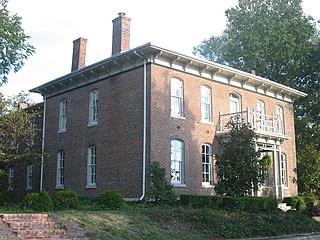
The Badollet House is one of three properties listed on the National Register of Historic Places in the Marion County, Illinois county seat of Salem. The house was built for businessman Howard Badollet and his wife. The house was designed in the Italianate style and is the only surviving Italianate home in Salem. The two-story brick house consists of a front section completed in 1854 and a rear wing finished the following year. The decorative elements of the house were most likely added in the 1860s or 1870s. The house's hip roof features overhanging eaves and a bracketed cornice. The original front porch was replaced by a simpler two-story porch around 1900.

The William H. Copeland House is a home located in the Chicago suburb of Oak Park, Illinois, United States. In 1909 the home underwent a remodeling designed by famous American architect Frank Lloyd Wright. The original Italianate home was built in the 1870s. Dr. William H. Copeland commissioned Wright for the remodel and Wright's original vision of the project proposed a three-story Prairie house. That version was rejected and the result was the more subdued, less severely Prairie, William H. Copeland House. On the exterior the most significant alteration by Wright was the addition of a low-pitched hip roof. The house has been listed as a contributing property to a U.S. Registered Historic District since 1973.

The William H. Roberts House is a late 19th-century house located in Pecatonica, Illinois, United States. The house was built in 1883 for Dr. William H. Roberts, who died three years later at the age of 33. The building features a combination of elements from three distinct architectural styles, Italianate, Queen Anne and Gothic revival. The building functioned as both Roberts's house and office. The house is the only building in Pecatonica listed on the United States National Register of Historic Places, a status it attained in 1979.

Central House is an 1860s hotel building located in the 800-person village of Orangeville, in Stephenson County, Illinois, United States. The building was built by Orangeville founder John Bower and operated as a hotel from its construction until the 1930s, when it was converted for use as a single family residence. The three-story building was the first commercial brick structure in downtown Orangeville. Architecturally, the building is cast in a mid-19th-century Italianate style. Central House was added to the U.S. National Register of Historic Places in 1999.
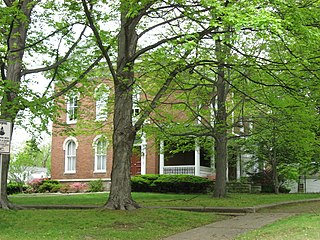
The Beall-Orr House is a historic house located at 503 Cherry St. in Mount Carmel, Illinois.

The Col. Nathan Whitney House is a historic house located at 1620 Whitney Road south of Franklin Grove, Illinois. The Italianate house was built for Colonel Nathan Whitney, a veteran of the War of 1812, in 1860. Whitney and his family settled in the Franklin Grove area in 1836 and founded the Franklin Grove Nursery and Orchards. The orchards became successful, and Whitney had four houses built for his family on the site, the 1860 house being the fourth.

The Robert L. Dulaney House is a historic house located at 602 North 7th Street in Marshall, Illinois.
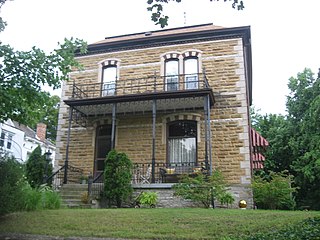
The Alexander Briggs House is a historic house located at 210 Jackson St. in Charleston, Illinois. Prominent local stonemason Alexander Briggs built the stone house in 1894; it is the only stone house remaining in Coles County. The house's design incorporates features of the Italianate and Renaissance Revival styles; the combination is unusual, as the Renaissance Revival style was rarely used in small houses. Briggs built the house with multicolored sandstone and used marble and granite to form decorative belt courses and quoins, giving the house its Renaissance Revival appearance. The house's Italianate elements include its tall, narrow arched windows and its gently sloping roof.

The Rippon-Kinsella House is a historic house located at 1317 North Third Street in Springfield, Illinois. The house was most likely built in 1871 for businessman John Rippon, Jr. Its original design was a simple Italianate plan; the style can still be seen in its bracketed eaves and its long arched windows with round hoods. Rippon sold the house in 1891, and after passing through several other owners it was bought by Richard "Dick" Kinsella in 1899. Kinsella ran a local wallpaper and paint business, worked as a scout for the New York Giants baseball team, and was a prominent Sangamon County Democrat. In 1905, Kinsella remodeled his house to incorporate Classical elements; the house's porch with Doric columns and its high-pitched roof were added at this time. Classical Revival architecture was popular in both new and remodeled houses in Springfield at the time, and the more traditional Italianate houses were well-suited to renovations; the house is one of the best-preserved examples of these hybrid designs.
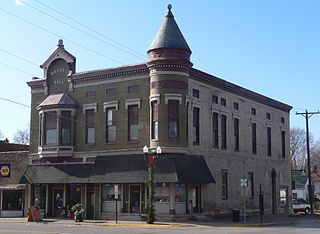
The Delavan Commercial Historic District is a historic district in downtown Delavan, Illinois. The district includes 26 buildings along two blocks of Locust Street, 20 of which are contributing buildings. The oldest buildings in the district, two simple brick commercial structures, were built around 1860. The remaining buildings were mainly built later in the 19th century, with a few built during the early 20th century. The buildings mostly have either Italianate or vernacular commercial designs, as was typical for commercial buildings of the period. Several of the buildings feature decorative metal elements such as storefronts, cornices, and window treatments. One notable exception to this design trend is the Masonic Hall at 401 Locust Street, which has a Queen Anne design featuring a large turret.

The Stapleford–Hoover–Whitney House is a historic house located at 401 North Main Street in Vermont, Illinois. Built circa 1855, the house was twice remodeled and incorporates elements of three different architectural styles. The original house was built for businessman and speculator Edward Stapleford; it had an I-house plan with a Greek Revival design, which is still reflected in its entrance and windows. Stapleford hanged himself in 1857 after going into debt via a speculation gone wrong; his wife Sarah lived in the house until 1871, when it was purchased by Dr. A. L. Hoover. Hoover, who ran a medical practice in the village, added the house's Italianate features, which included a hip roof with a bracketed cornice and two ornate porches. Merchant George F. Whitney bought the house in the 1880s; his wife and son added the Queen Anne style bay window in 1892.

The Henry H. Page House is a historic house located at 221 North Union Street in Vermont, Illinois. Horse breeder Henry H. Page had the house built for his family in 1912–13. The house's design reflects a contemporary trend which architectural historian Alan Gowans described as Picturesque Eclectic; while its form distinctly fits a recognizable style, in its case the American Foursquare, its ornamentation borrows from multiple different styles. The large front gable dormer, which includes a horseshoe arch opening and decorated spandrels, is a Queen Anne feature. The cornice features both bracketing and stickwork, decorative elements of the Italianate and Stick styles respectively. The brick piers supporting the front porch come from the American Craftsman style, while the leaded windows are Classical Revival elements.
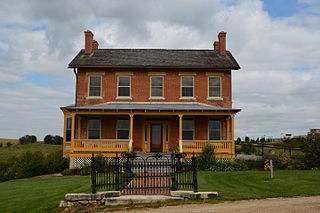
The Henry W. Miller House is a historic house located at 11672 West Norris Lane in Galena, Illinois. Henry W. Miller, a flour wholesaler and dealer who played an important role in Galena's large flour-producing industry, had the house built between 1847 and 1850. The house was built on a plot of land overlooking the plank toll road that connected Galena to Dubuque, Iowa and Mineral Point, Wisconsin; the route, which is now part of U.S. Route 20, eventually became known for its collection of large, elaborate homes. Miller chose the popular Greek Revival style for his house; its design features sidelights and a transom around the front door, a door surround with pilasters and dentillation, and a symmetrical front with six-over-six windows. Richard Barrett, who owned the house in the 1870s, added its Italianate bay window.
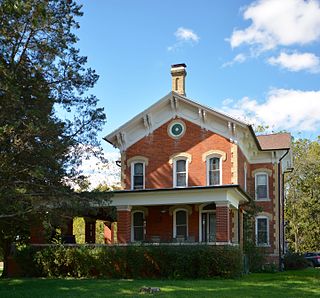
The Wood–Tellkamp House is a historic house located at 82 Main Street in La Moille, Illinois. Charles C. Wood, a local farmer, built the house circa 1872 upon his retirement. The house's Italianate design was the most elaborate in the village at the time of its completion. The design featured a red brick exterior with quoins in yellow brick, tall arched windows with yellow brick hoods, paired brackets under the eaves, and two marble fireplaces. Between 1914 and 1917, owners Henry and Louise Tellkamp added a Neoclassical porch with square columns to the east and south sides of the house.

The Martin House is a historic house located at 707 10th Avenue in Fulton, Illinois. The Italianate house was built in 1855, when the style was becoming popular nationally. The house features a hip roof with bracketed eaves, tall windows, and a bay window on the east side, all distinctive Italianate elements. A wraparound front porch, a Queen Anne element, was added circa 1898. A 1908 renovation of the entry hall and dining room added Eastlake elements to the former and gave the latter an Arts and Crafts design.

The Dohrmann-Buckman House is a historic house at 8455 W. Grand Avenue in River Grove, Illinois. The house was built in 1875 for original owner Frederick Dohrmann. It has a gable front plan with an Italianate design that includes a front porch with columns and a frieze, a glazed transom above the entrance, and segmental arched windows on the second floor. River Forest village clerk Henry Buckman and his wife Bertha acquired the house in 1890; the couple placed two additions on the house and built a barn on the property. The house remained in the Buckman family until 1992, when it became a historic house museum.

The Tiedemann House is a historic house at 212 W. Washington St. in O'Fallon, Illinois. The house was built in 1884 for Ernst Tiedemann, a local merchant and a member of the city's board of trustees. Architect Henry E. Peipers of St. Louis designed the house using elements of the Italianate and Queen Anne styles. The house's Italianate features include its front porch, the three-sided bay window on its front facade, and its segmental arch windows. Its Queen Anne influence can be seen in the wooden balustrade on its porch and the gabled dormers with half-moon windows on each side of its hip roof.
The Henson House is a historic house at 103 N. Henson Road in Villa Grove, Illinois. The house was built in 1871 for George W. Henson, a local landowner and a major figure in Villa Grove's establishment. The Henson House was the first house in the Villa Grove area, and Henson sold the city's original site to the Chicago & Eastern Illinois Railroad when it built a line through the area; even the city's name came from a nickname for the Henson House, "the villa in the grove". The house originally had an Italianate design, which can still be seen in its projecting bay window and its tall arched windows. Later redesigns of the house introduced elements of the Neoclassical style, such as the columns and pediment on its front porch, and the Arts and Crafts style, such as the wooden front doors.

The Colonel George H. Paddock House is a historic house at 906 South Main Street in Princeton, Illinois. Built in 1903, the house was designed with elements of the Queen Anne and Neoclassical styles. As is typical of Queen Anne buildings, the house has an asymmetrical shape with a complex cross-gabled roof. The front of the house features a wraparound porch supported by Doric columns. The house's windows include both stained glass windows and projecting bay windows typical of the Queen Anne style and pedimented triple windows typical of Neoclassical architecture.





















